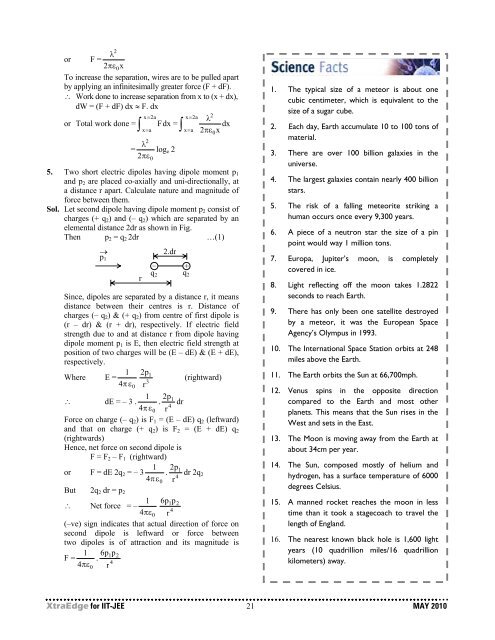Create successful ePaper yourself
Turn your PDF publications into a flip-book with our unique Google optimized e-Paper software.
2<br />
λ<br />
or F =<br />
2πε0x<br />
To increase the separation, wires are to be pulled apart<br />
by applying an infinitesimally greater force (F + dF).<br />
∴ Work done to increase separation from x to (x + dx),<br />
dW = (F + dF) dx ≈ F. dx<br />
or Total work done =<br />
∫ = x=<br />
x<br />
2<br />
a<br />
λ<br />
=<br />
2πε<br />
2a<br />
0<br />
x<br />
F dx =<br />
∫ = 2a λ<br />
x= a 2πε<br />
log e 2<br />
2<br />
0<br />
dx<br />
x<br />
5. Two short electric dipoles having dipole moment p 1<br />
and p 2 are placed co-axially and uni-directionally, at<br />
a distance r apart. Calculate nature and magnitude of<br />
force between them.<br />
Sol. Let second dipole having dipole moment p 2 consist of<br />
charges (+ q 2 ) and (– q 2 ) which are separated by an<br />
elemental distance 2dr as shown in Fig.<br />
Then p 2 = q 2 2dr …(1)<br />
→<br />
p 1<br />
r<br />
2.dr<br />
– +<br />
q 2 q 2<br />
Since, dipoles are separated by a distance r, it means<br />
distance between their centres is r. Distance of<br />
charges (– q 2 ) & (+ q 2 ) from centre of first dipole is<br />
(r – dr) & (r + dr), respectively. If electric field<br />
strength due to and at distance r from dipole having<br />
dipole moment p 1 is E, then electric field strength at<br />
position of two charges will be (E – dE) & (E + dE),<br />
respectively.<br />
1 2p1<br />
Where E =<br />
(rightward)<br />
3<br />
4πε<br />
r<br />
0<br />
∴<br />
1 2p1<br />
dE = – 3 . . dr<br />
4<br />
4πε0<br />
r<br />
Force on charge (– q 2 ) is F 1 = (E – dE) q 2 (leftward)<br />
and that on charge (+ q 2 ) is F 2 = (E + dE) q 2<br />
(rightwards)<br />
Hence, net force on second dipole is<br />
F = F 2 – F 1 (rightward)<br />
or<br />
1 2p1<br />
F = dE 2q 2 = – 3 . dr 2q<br />
4 2<br />
4πε0<br />
r<br />
But 2q 2 dr = p 2<br />
∴<br />
1 6p1p2<br />
Net force = –<br />
4<br />
4πε0<br />
r<br />
(–ve) sign indicates that actual direction of force on<br />
second dipole is leftward or force between<br />
two dipoles is of attraction and its magnitude is<br />
1<br />
F =<br />
4πε 6p1p2<br />
4<br />
r<br />
0<br />
1. The typical size of a meteor is about one<br />
cubic centimeter, which is equivalent to the<br />
size of a sugar cube.<br />
2. Each day, Earth accumulate 10 to 100 tons of<br />
material.<br />
3. There are over 100 billion galaxies in the<br />
universe.<br />
4. The largest galaxies contain nearly 400 billion<br />
stars.<br />
5. The risk of a falling meteorite striking a<br />
human occurs once every 9,300 years.<br />
6. A piece of a neutron star the size of a pin<br />
point would way 1 million tons.<br />
7. Europa, Jupiter’s moon, is completely<br />
covered in ice.<br />
8. Light reflecting off the moon takes 1.2822<br />
seconds to reach Earth.<br />
9. There has only been one satellite destroyed<br />
by a meteor, it was the European Space<br />
Agency’s Olympus in 1993.<br />
10. The International Space Station orbits at 248<br />
miles above the Earth.<br />
11. The Earth orbits the Sun at 66,700mph.<br />
12. Venus spins in the opposite direction<br />
compared to the Earth and most other<br />
planets. This means that the Sun rises in the<br />
West and sets in the East.<br />
13. The Moon is moving away from the Earth at<br />
about 34cm per year.<br />
14. The Sun, composed mostly of helium and<br />
hydrogen, has a surface temperature of 6000<br />
degrees Celsius.<br />
15. A manned rocket reaches the moon in less<br />
time than it took a stagecoach to travel the<br />
length of England.<br />
16. The nearest known black hole is 1,600 light<br />
years (10 quadrillion miles/16 quadrillion<br />
kilometers) away.<br />
XtraEdge for <strong>IIT</strong>-<strong>JEE</strong> 21 MAY 2010

















